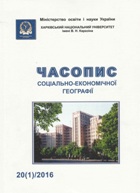Recreational potential evaluation of the perspective national park «Lisova pisnia»
Abstract
The recreational potential of Turia and Stokhid middle watershed geosystem is studied. Historical and cultural, recreational and wellness, ecological environmental components of that potential are identified as significant factors of the National Park organization herein. Creation of new national parks and their delineation must be scientifically justified and conform to the requirements of the laws of Ukraine. Also an important criterion is the presence of national historical heritage and humanistic resource potential. The article stresses the need to preserve landscapes which became known worldwide thanks to the Lesya Ukrainka’s work. That landscapes with high recreational potential which forms totemic, sacred relation to the landscape as to the native land. Nechymne lake – the live scenery of the Lesya Ukrainka’s immortal piece, a cradle of the “Lisova pisnia”. Esthetic and recreational potential of Krychevytske, Mezhyliske and Povorske lakes, biotic diverse of landscape complexes which survived in the middle flow of Turiya and Stokhid are paid attention in the article.
The article underlines the role of landscapes in the educational and ecological tourism development. In placing of components of the “Lisova pisnia” national park humanistic resource potential historical and cultural carcass was highlighted. The carcass formed by memorial items related to Lesya Ukrainka (Nechymne tract, Skulyn village, “Lisova pisnia” museum), architectural monuments (Dmytrivska church at the Gishin village – the oldest monument of wooden architecture at Volyn’ region and temple facilities in Krychevychi, Cheremoshne and Skulyn villages), old-military and sacred elements (including monument to fighters for freedom of Ukraine around Skulyn village where the first UPA troops in Volyn were forming in 1942 etc.). Territorial distribution of carcass and others elements of humanistic potential displays the authors map. Stance on research area humanistic potential set out in article and coincides with recommendation of the European Convention of landscapes essence of which is in the need to enhance the role of landscape as witness of history, as the cradle of European cultural identity, common heritage and the diversity of Europe.
Downloads
References
2. Hetman, V.I. (2002). Ekoturyzm u natsionalnykh parkakh. Ekologichnyi Visnyk, 7–8, 24-27.
3. Dmytruk, O.Yu., Dmytruk, S.V. (2009). Ekologichnyi turyzm: navch. posib. K.: Alterpres, 358.
4. Matsola, V.I. (1997). Rekreatsiyno-turystychnyi kompleks Ukrainy. Lviv: In-t region. doslidzh. NANU, 259.
5. Mishchenko, O.V. (2010). Teoretychni osnovy vyznachennya sutnosti ekolohichnoho turyzmu. Nauk. visn. Volyn. nats. un-tu im. Lesi Ukrainky. Geogr. Nauky, 3, 155-160.
6. Khymyn, M. (1999). Pryrodno-zapovidnyi fond Volynskoi oblasti. Lutsk: Initsial, 48.
7. Andrienko, T.L, Plyuta, P.G., Pryadko, E.I., Karkutsyev, G.N. (1991). Sotsialno-ekologicheskaya znachimost prirodno-zapovednykh territoriy Ukrainy. In-t botaniki im. N.G. Kholodnogo AN USSR. K.: Nauk. dumka, 160.
8. Cherchykб L.M., Mishchenkoб O.V. Rekreatsiyna tsinnist terytorii Natsionalnoho pryrodnoho parku «Prypyat' − Stokhid». Available at: http://esnuir.eenu.edu.ua/bitstream/123456789/230/1/Cherchyk.pdf
9. Shulgach, A.S. (2015). Landshaftne riznomanittya perspektyvnoho natsionalnoho pryrodnoho parku «Lisova pisnya». Fizychna geografiya ta geomorfologiya, 4 (80), I, 71-76.




